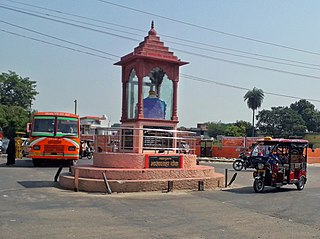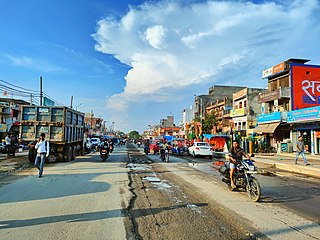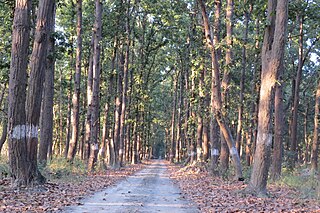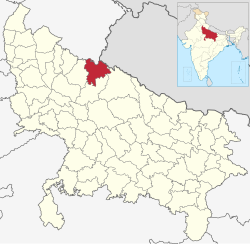
Bareilly is a city in Bareilly district in the Indian state of Uttar Pradesh. It is among the largest metropolises in Western Uttar Pradesh and is the centre of the Bareilly division as well as the historical region of Rohilkhand. The city lies in the Indo-Gangetic Plains, about 252 kilometres (157 mi) northwest of the state capital, Lucknow, and 265 kilometres (165 mi) east of the national capital, New Delhi. With a population of 903,668 in 2011, it is the eighth most populous city in the state, 17th in northern India and 54th in India. It is located on the bank of Ramganga River and is the site of the Ramganga Barrage built for canal irrigation.

Bareilly division is one of the 18 administrative geographical unit of the northern Indian state of Uttar Pradesh. Bareilly city is the administrative headquarters of the division. Part of the Rohilkhand region, Bareilly division consists of four major districts in western Uttar Pradesh - Bareilly, Badaun, Pilibhit and Shahjahanpur.

Budaun is a medieval city and headquarters of Budaun district, in the Indian state of Uttar Pradesh. It is located about a mile east of the Sot river, and 27 km north of the Ganges, in the Rohilkhand region of Uttar Pradesh. According to the 2011 census, it has a population of 159,221, which is projected at 161,555 at present. Budaun rose to historical importance as the capital of the Delhi Sultanate for four years from 1210 CE to 1214 CE during the reign of Sultan Iltutmish. It was the most important post of Northern Frontier during Mughal reign. Budaun is a big market, historically famous and religiously important city. Budaun is 230 km south-east of New Delhi and 245 km north-west of Lucknow, both taking about 6 hours by road.

Badaun district is one of the districts of Uttar Pradesh state of India, with its headquarters in the town of Badaun. The district is part of the Bareilly division, and covers an area of 4,234 km2 (1,635 sq mi). According to legend, Budaun was named after the Ahir prince Budh.

Pilibhit is a city and a municipal board in Pilibhit district in the northern Indian state of Uttar Pradesh. Pilibhit is the north-easternmost district of Bareilly division, situated in the Rohilkhand region of the sub-Himalayan Plateau belt next to foothills of Sivalik Range on the boundary of Nepal, known for the origin of river Gomati and one of the most forest-rich areas in North India. Pilibhit was also known as Bansuri Nagari – the land of flutes, for making and exporting roughly 95% of India's flutes.

Shahjahanpur is a district of Uttar Pradesh India. It is a part of Bareilly division. It was established in 1813 by the British Government. Previously it was a part of district Bareilly. Geographically the main town is Shahjahanpur which is its headquarters. Its 4 Tehsils are: Powayan, Tilhar, Jalalabad and Sadar.

Lakhimpur Kheri district is the largest district in Uttar Pradesh, India, on the border with Nepal. Its administrative capital is the city of Lakhimpur.
Bisalpur is a City and a municipal board situated nearby Pilibhit City in the Pilibhit district of the state of Uttar Pradesh, India. The town is known for its sugar factory as well as its annual Ram Leela and Dushera festival. Bisalpur is in between the two rivers, in West Doha river and in East katna river. Before formation of new District Pilibhit, Bisalpur was under the District Bareilly. In 1913 AD after formation of new District Pilibhit, Bisalpur has come under District Pilibhit Administration. this city is well connected with 03 major cities. Bisalpur is just 290 km away from National capital New Delhi and 250 km from the state capital Lucknow. Bisalpur is famous for Annual Ramleela Fest, Dubey Taalab, Guleshwarnath Temple, Dargah Hazrat Gazi kamaal Degree college and Nagaich Market. Bisalpur is known for many things and places and people of Bisalpur have contributed in various fields one such example is Freedom fight Raees Mohammad who was a freedom fighter and a military man resident of mohalla gyaspur he have won many medals for his extraordinary work he did for the country. he is well known for his charm and Character he played in the public domain now his generation resides in the Bisalpur mohalla gyaspur. Another important place is its railway station which has been modified for the broad gauge. This will help to get well connected with different cities of India.
Powayan or Pawayan is a town and a subdivisional headquarters in Shahjahanpur district in the Indian state of Uttar Pradesh, 27 km from Shahjahanpur, 47km from Tilhar. It is located in the fertile agricultural belt of Northern India and is 300 km from Delhi and 200 km from Lucknow.
Puranpur is a town and a municipal board in Pilibhit district in the Indian state of Uttar Pradesh. Puranpur is divided into 25 wards for which elections are held every 5 years. After independence and Partition of India the large numbers of Sikhs migrated and settled in the Puranpur Region. Due to dense Sikh population and their lifestyle, The area is also known as Mini Punjab as after Partition of India in 1947.Sikh people own their properties and lands in this area. There are numerous Sikh temples in Puranpur.
Rithora is a town and a nagar panchayat in Bareilly Tehsil of Bareilly district in the Indian state of Uttar Pradesh.

Jahanabad is a town and a nagar panchayat in Pilibhit district in the Indian state of Uttar Pradesh. Community Health Center (CHC) is situated near bazar Jagdeeshpur road. CHC is providing health facilities to community. CHC is under department of medical, health & family welfare. CHC Jahanabad is under block Lalaurikhera.

Nawabganj is a Nagar palika and an administrative subdivision of Bareilly district in the Indian state of Uttar Pradesh. A Sub Divisional Magistrate, also called Sub Divisional Officer, or pargana-adhikari is the head official.

Pilibhit Tiger Reserve is located in Pilibhit district of Uttar Pradesh and was notified as a tiger reserve in 2014. It forms part of the Terai Arc Landscape in the upper Gangetic Plain along the India-Nepal border. The habitat is characterized by sal forests, tall grasslands and swamp maintained by periodic flooding from rivers. The Sharda Sagar Dam extending up to a length of 22 km (14 mi) is on the boundary of the reserve.

Situated in the northern part of India, bordering with the capital of India New Delhi, Uttar Pradesh is one of the most popular and an established tourist destination for both Indians and non-Indians alike in India. The most populous state of India, Uttar Pradesh contains many historical monuments and places of religious significance. Geographically, Uttar Pradesh is very diverse, with Himalayan foothills in the extreme north and the Gangetic Plain in the centre. It is also home of India's most visited sites, Hinduism's holiest city, Varanasi. Kumbh city, Prayagraj. Kathak, one of the eight forms of Indian classical dances, originated from Uttar Pradesh. Uttar Pradesh is at the heart of India, hence it is also known as The Heartland of India. Cuisine of Uttar Pradesh like Awadhi cuisine, Mughlai cuisine and Bhojpuri cuisine are very famous not only in India but also many places abroad.
Amkhiriya is a village in Block Amariya, Tehsil and District Pilibhit in the Indian state of Uttar Pradesh. Amkhiriya have some British Government historical Building. These British Government Buildings served as guest houses for British army and other British employees during the pre-independence era.
Barkhera Assembly constituency is one of the 403 constituencies of the Uttar Pradesh Legislative Assembly, India. It is a part of the Pilibhit district and one of the five assembly constituencies in the Pilibhit Lok Sabha constituency. First election in this assembly constituency was held in 1967 after the "DPACO (1967)" was passed in 1967. After the "Delimitation of Parliamentary and Assembly Constituencies Order" was passed in 2008, the constituency was assigned identification number 128.
Puranpur Assembly constituency is one of the 403 constituencies of the Uttar Pradesh Legislative Assembly, India. It is a part of the Pilibhit district and one of the five assembly constituencies in the Pilibhit Lok Sabha constituency. First election in this assembly constituency was held in 1962 after the "DPACO (1961)" was passed in 1961. After the "Delimitation of Parliamentary and Assembly Constituencies Order" was passed in 2008, the constituency was assigned identification number 129.
Puranpur Khas (Rural) is a village in Puranpur Tehsil, Pilibhit District, Uttar Pradesh, India. It sits near the northern border with Nepal, about 35 kilometres southeast of the district seat Pilibhit, and 1 kilometres southeast of the tehsil seat Puranpur. At the 2011 Census, the village's population was 35,948.




















